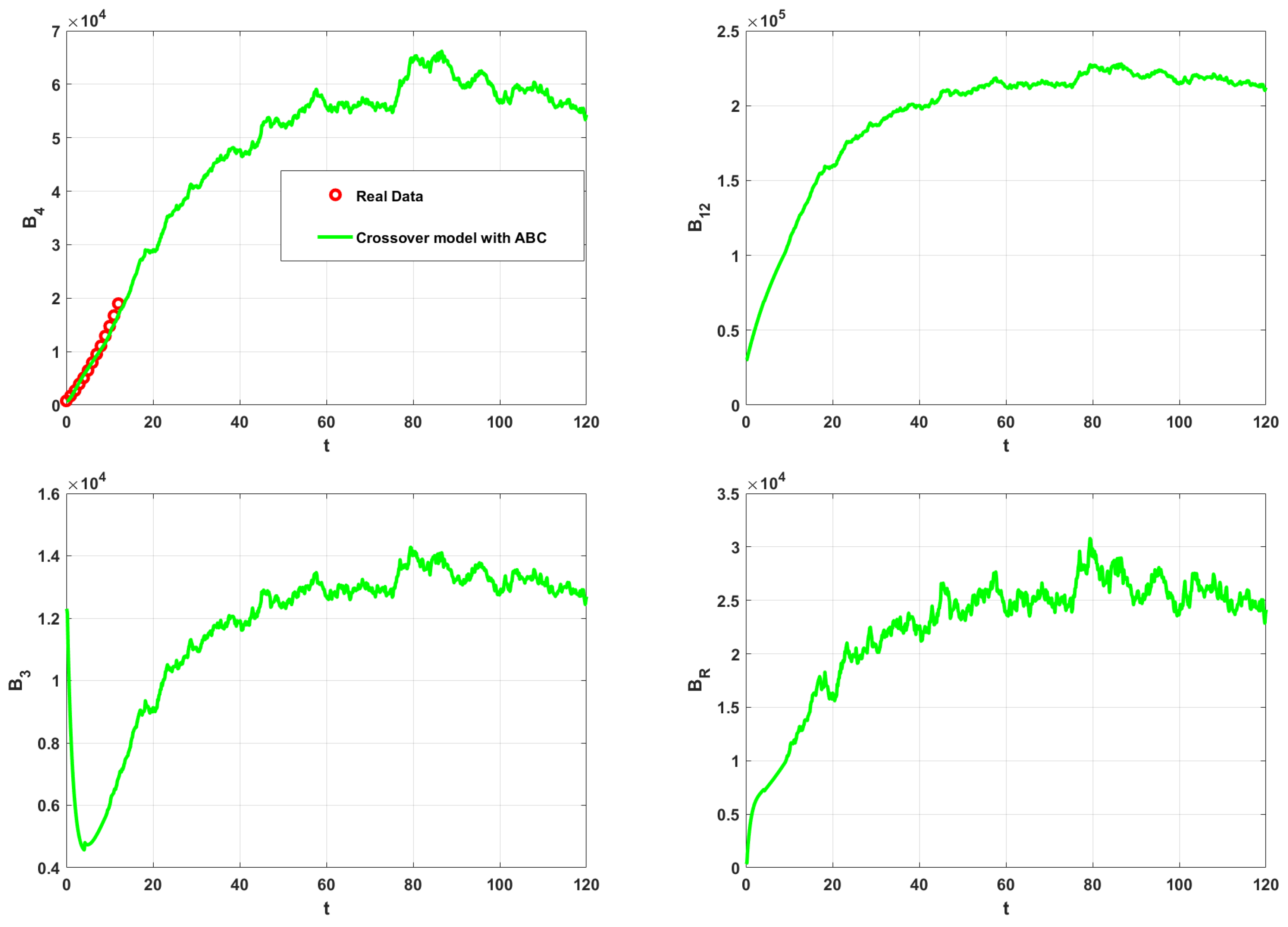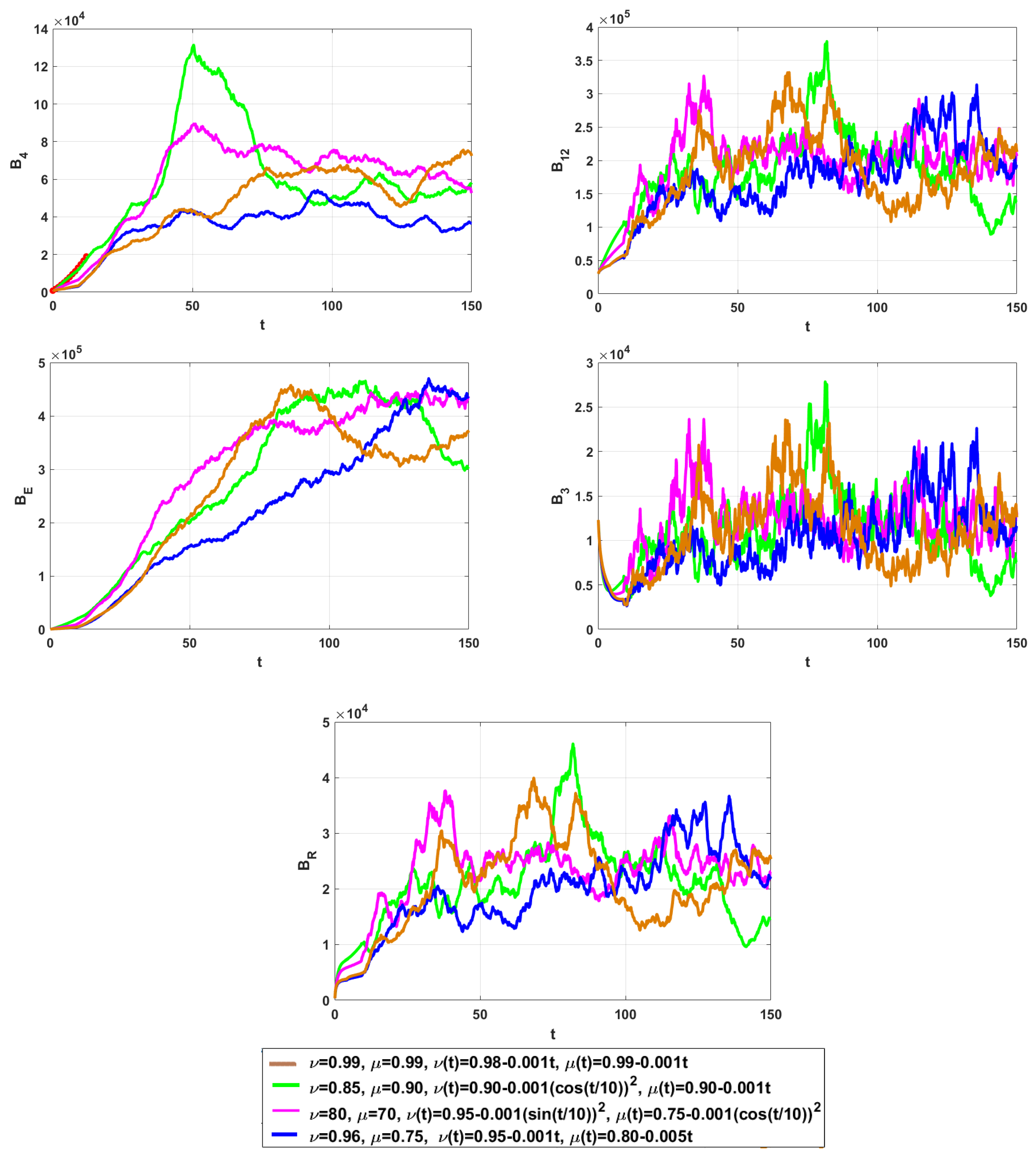Comparative Study of Crossover Mathematical Model of Breast Cancer Based on Ψ-Caputo Derivative and Mittag-Leffler Laws: Numerical Treatments
Abstract
1. Introduction
2. Preliminaries and Notations
3. The Piecewise Mathematical Model
3.1. Breast Cancer Model Based on Fractal (Fractional and Variable Order) -Caputo Derivative
3.2. Breast Cancer Model Based on Fractal (Fractional and Variable Order) Mittag-Leffler Laws
3.3. The Points of Equilibrium and Their Analysis
4. Numerical Methods for the Proposed Models
4.1. -NSFDM
4.2. NMEMM
Stability of the Proposed Method
- h: The choice of the step size h significantly affects stability. Smaller step sizes generally improve stability but increase computational cost.
- Weights : The stability also depends on the specific form of the weights .
- Function : The function influences the stability through the term . The proper selection of can enhance stability.
4.3. Numerical Method for Crossover Non-Singular Kernel Fractal (Fractional–Variable) Order Models
Toufik–Atangana Method
4.4. NMEMM
5. Numerical Simulations
6. Conclusions
Author Contributions
Funding
Data Availability Statement
Acknowledgments
Conflicts of Interest
References
- Fitzmaurice, C.; Dicker, D.; Pain, A.; Hamavid, H.; Moradi-Lakeh, M.; MacIntyre, M.F.; Allen, C.; Hansen, G.; Woodbrook, R.; Wolfe, C.; et al. The global burden of cancer 2013. JAMA Oncol. 2015, 1, 505–527. [Google Scholar] [CrossRef] [PubMed]
- DeSantis, C.E.; Bray, F.; Ferlay, J.; Lortet-Tieulent, J.; Anderson, B.O.; Jemal, A. International variation in female breast cancer incidence and mortality rate international variation in female breast cancer rates. Cancer Epidemiol. Biomark. Prev. 2015, 24, 1495–1506. [Google Scholar] [CrossRef] [PubMed]
- Tang, T.-Q.; Shah, Z.; Bonyah, E.; Jan, R.; Shutaywi, M.; Alreshidi, N. Modeling and analysis of breast cancer with adverse reactions of chemotherapy treatment through fractional derivative. Comput. Math. Methods Med. 2022, 2022, 5636844. [Google Scholar] [CrossRef]
- Alzahrani, E.; El-Dessoky, M.; Khan, M.A. Mathematical model to understand cancer dynamics, prevention diagnosis, and therapy. Mathematics 2023, 11, 1975. [Google Scholar] [CrossRef]
- Vasiliadis, I.; Kolovou, G.; Mikhailidis, D. Cardiotoxicity and cancer therapy. Angiology 2024, 65, 369–371. [Google Scholar] [CrossRef]
- Dave, D.K.; Shah, T.P. Stability analysis and z-control of breast cancer dynamics. Adv. Appl. Math. Sci. 2021, 21, 343–363. [Google Scholar]
- Solís-Pérez, J.E.; Gómez-Aguilar, J.F.; Atangana, A. A fractional mathematical model of breast cancer competition model. Chaos Solitons Fractals 2019, 127, 38–54. [Google Scholar] [CrossRef]
- Chavada, A.; Pathak, N.; Raval, R. Fractional mathematical modeling of breast cancer stages with true data from Saudi Arabia. Results Control Optim. 2024, 15, 100431. [Google Scholar] [CrossRef]
- Atangana, A.; Araz, S.İ. New concept in calculus: Piecewise differential and integral operators. Chaos Solitons & Fractals 2021, 145, 110638. [Google Scholar]
- NSweilam, H.; AL-Mekhlafi, S.M.; Hassan, S.M.; Alsunaideh, N.R.; Radwan, A.E. A Novel Hybrid Crossover Dynamics of Monkeypox Disease Mathematical Model with Time Delay: Numerical Treatments. Fractal Fract. 2024, 8, 185. [Google Scholar] [CrossRef]
- Alalhareth, F.K.; Al-Mekhlafi, S.M.; Boudaoui, A.; Laksaci, N.; Alharbi, M.H. Numerical treatment for a novel crossover mathematical model of the COVID-19 epidemic. AIMS Math. 2024, 9, 5376–5393. [Google Scholar] [CrossRef]
- Awadalla, M.; Noupoue, Y.Y.Y.; Asbeh, K.A.; Ghiloufi, N. Modeling drug concentration level in blood using fractional differential equation based on Ψ-Caputo derivative. J. Math. 2022, 2022, 9006361. [Google Scholar] [CrossRef]
- Wanassi, O.K.; Torres, D.F.M. Modeling blood alcohol concentration using fractional differential equations based on the Ψ-Caputo derivative. Math. Meth. Appl. Sci. 2024, 47, 7793–7803. [Google Scholar] [CrossRef]
- Mohammadaliee, B.; Roomi, V.; Samei, M.E. SEIARS model for analyzing COVID-19 pandemic process via Ψ-Caputo fractional derivative and numerical simulation. Sci. Rep. 2024, 14, 723. [Google Scholar] [CrossRef]
- Solis-Perez, J.E.; Gómez-Aguilar, J.F. Variable-order fractal-fractional time delay equations with power, exponential and Mittag-Lefer laws and their numerical solutions. Eng. Comput. 2022, 38, 555–577. [Google Scholar] [CrossRef]
- Gómez-Aguilar, J.F.; Rosales-García, J.J.; Bernal-Alvarado, J.J.; Córdova-Fraga, T.; Guz-mán-Cabrera, R. Fractional mechanical oscillators. Rev. Mex. Fis. 2012, 58, 348–352. [Google Scholar]
- Gómez-Aguilar, J.F.; Atangana, A. New insight in fractional differentiation: Power, exponential decay and Mittag-Leffler laws and applications. Eur. Phys. J. Plus 2017, 132. [Google Scholar] [CrossRef]
- Haq, I.; Ali, N.; Ahmad, H.; Sabra, R.; Albalwi, M.D.; Ahmad, I. Mathematical analysis of a coronavirus model with Caputo, Caputo-Fabrizio–Caputo fractional and Atangana–Baleanu–Caputo differ-ential operators. Int. J. Biomath. 2023, 23, 2350085. [Google Scholar] [CrossRef]
- Ul Haq, I.; Ali, N.; Bariq, A.; Akgül, A.; Baleanu, D.; Bayram, M. Mathematical modeling of COVID-19 outbreak using Caputo fractional derivative: Stability analysis. Appl. Math. Sci. Eng. 2024, 32, 2326982. [Google Scholar] [CrossRef]
- Owolabi, K.M.; Atangana, A. On the formulation of Adams-Bashforth scheme with Atan-gana-Baleanu-Caputo fractional derivative to model chaotic problems. Chaos 2019, 29, 023111. [Google Scholar] [CrossRef]
- Toufik, M.; Atangana, A. New numerical approximation of fractional derivative with non-local and non-singular kernel: Application to chaotic models. Eur. Phys. J. Plus 2017, 132, 1–16. [Google Scholar] [CrossRef]
- Kumar, A.; Shaw, P.K.; Kumar, S. Numerical investigation of pine wilt disease using frac-tal-fractional operator. Indian J. Phys. 2024. [Google Scholar] [CrossRef]
- Kumar, S.; Chauhan, R.P.; Momani, S.; Hadid, S. Numerical investigations on COVID-19 model through singular and non-singular fractional operators. Numer. Methods Part. Differ. Equ. 2024, 40, e22707. [Google Scholar] [CrossRef]
- Samko, S.G.; Kilbas, A.A.; Marichev, O.I. Fractional Integrals and Derivatives; Gordon and Breach Science Publishers: Yverdon, Switzerland, 1993. [Google Scholar]
- Kilbas, A.A.; Srivastava, H.M.; Trujillo, J.J. Theory and Applications of Fractional Differential Equations; North-Holland Mathematics Studies; Elsevier Science B.V.: Amsterdam, The Netherlands, 2006. [Google Scholar]
- Almeida, R.; Malinowska, A.B.; Monteiro, M.T.T. Fractional differential equations with a Caputo derivative with respect to a kernel function and their applications. Math. Methods Appl. Sci. 2018, 41, 336–352. [Google Scholar] [CrossRef]
- Atangana, A. Fractal-fractional differentiation and integration: Connecting fractal calculus and fractional calculus to predict complex system. Chaos Soliton Fract. 2017, 102, 396–406. [Google Scholar] [CrossRef]
- Mickens, R.E. Nonstandard Finite Difference Models of Differential Equations; World Scientific: Singapore, 2005. [Google Scholar]
- Atangana, A.; Qureshi, S. Modeling attractors of chaotic dynamical systems with frac-tal-fractional operators. Chaos Solitons Fractals 2019, 123, 320–337. [Google Scholar] [CrossRef]
- Sweilam, N.H.; AL-Mekhlafi, S.M.; Mohamed, D.G. Novel chaotic systems with fractional differential operators: Numerical approaches. Chaos Solitons Fractals 2021, 142, 110475. [Google Scholar] [CrossRef]
- Hu, Y.; Liu, Y.; Nualart, D. Modified Euler approximation scheme for stochastic differential equations driven by fractional Brownian motions. arXiv 2013, arXiv:1306.1458. [Google Scholar]
- Atangana, A.; Araz, S. New Numerical Scheme with Newton Polynomial Theory, Methods, and Applications; Academic Press: Cambridge, MA, USA, 2021. [Google Scholar]

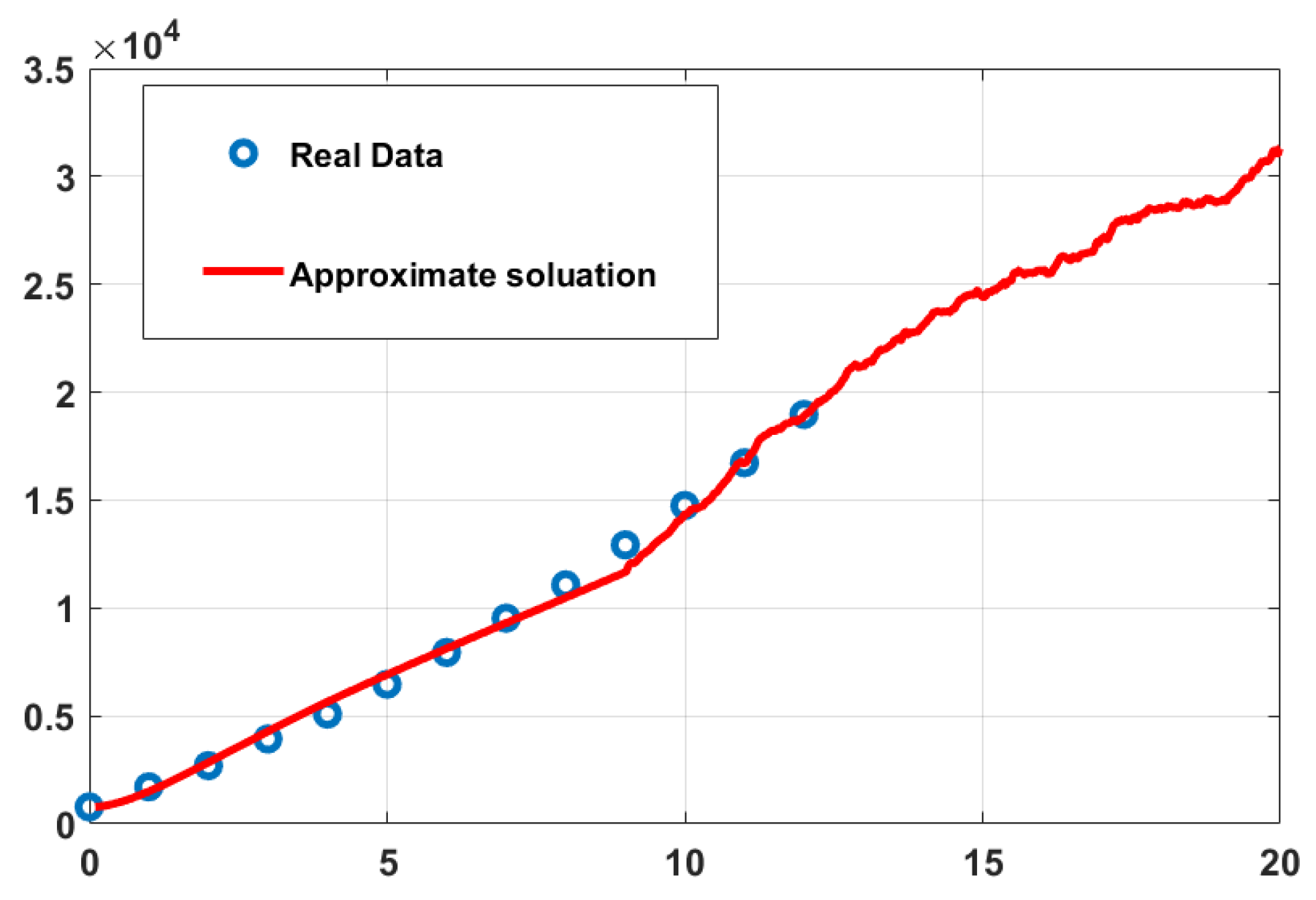

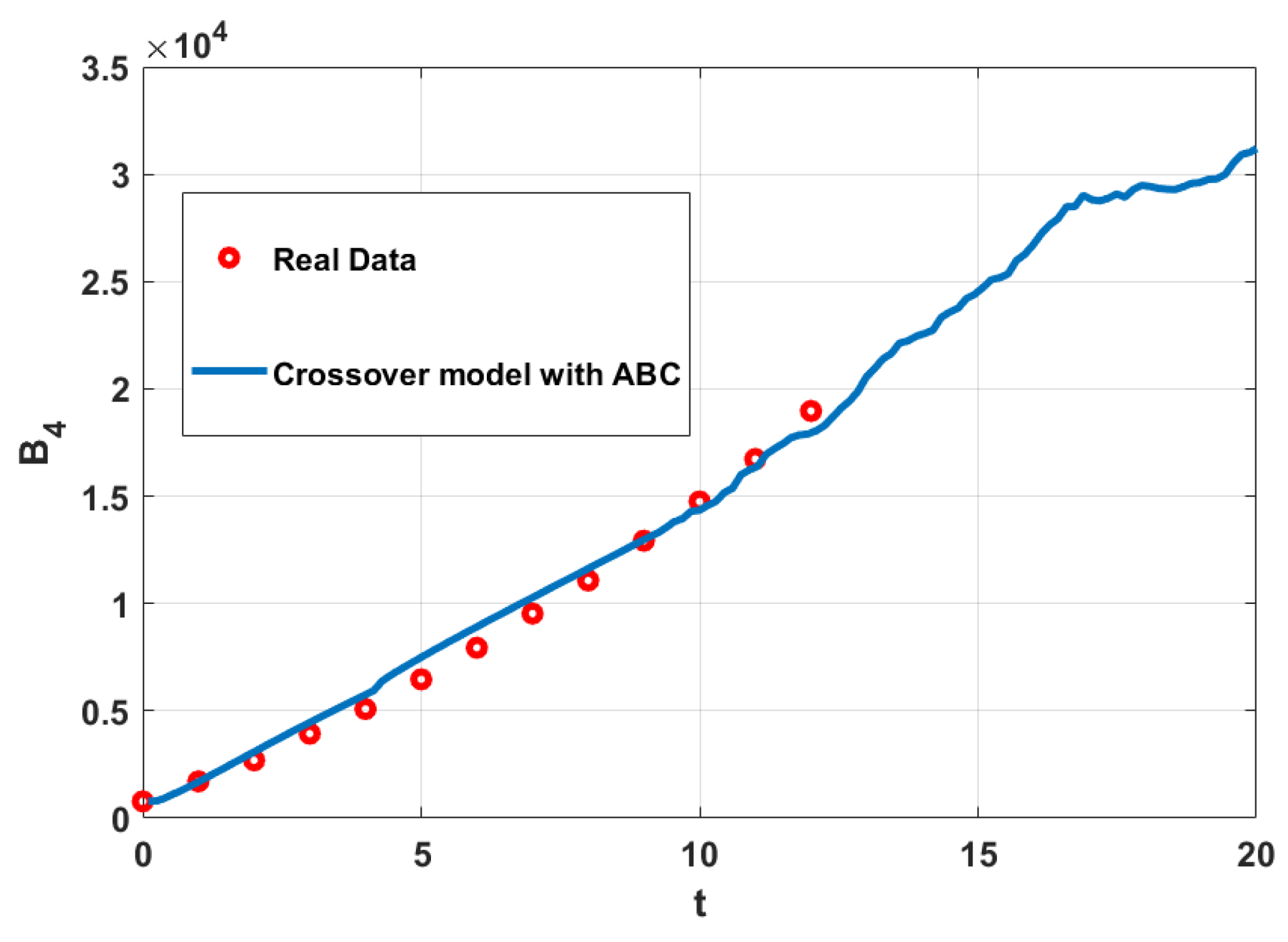
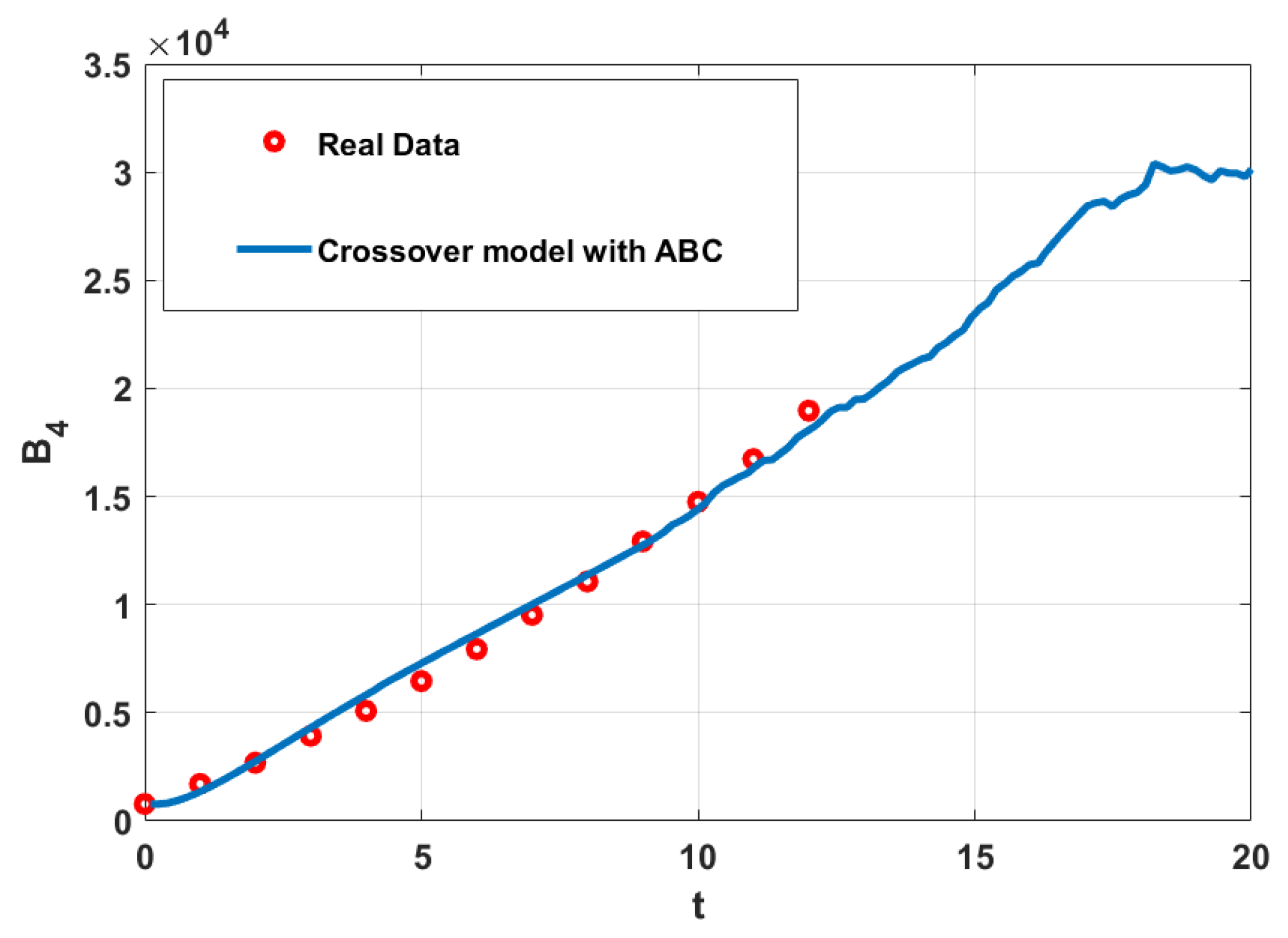
| The Variable | Description |
|---|---|
| Patients with stage one and stage two breast cancer. | |
| The group of people with stage three breast cancer. | |
| The group of people with stage four breast cancer. | |
| Number of breast cancer patients in a state free of the disease. | |
| Patients with cardiotoxic breast cancer in the population. |
Disclaimer/Publisher’s Note: The statements, opinions and data contained in all publications are solely those of the individual author(s) and contributor(s) and not of MDPI and/or the editor(s). MDPI and/or the editor(s) disclaim responsibility for any injury to people or property resulting from any ideas, methods, instructions or products referred to in the content. |
© 2024 by the authors. Licensee MDPI, Basel, Switzerland. This article is an open access article distributed under the terms and conditions of the Creative Commons Attribution (CC BY) license (https://creativecommons.org/licenses/by/4.0/).
Share and Cite
Sweilam, N.H.; Al-Mekhlafi, S.M.; Abdel Kareem, W.S.; Alqurishi, G. Comparative Study of Crossover Mathematical Model of Breast Cancer Based on Ψ-Caputo Derivative and Mittag-Leffler Laws: Numerical Treatments. Symmetry 2024, 16, 1172. https://doi.org/10.3390/sym16091172
Sweilam NH, Al-Mekhlafi SM, Abdel Kareem WS, Alqurishi G. Comparative Study of Crossover Mathematical Model of Breast Cancer Based on Ψ-Caputo Derivative and Mittag-Leffler Laws: Numerical Treatments. Symmetry. 2024; 16(9):1172. https://doi.org/10.3390/sym16091172
Chicago/Turabian StyleSweilam, Nasser H., Seham M. Al-Mekhlafi, Waleed S. Abdel Kareem, and Ghader Alqurishi. 2024. "Comparative Study of Crossover Mathematical Model of Breast Cancer Based on Ψ-Caputo Derivative and Mittag-Leffler Laws: Numerical Treatments" Symmetry 16, no. 9: 1172. https://doi.org/10.3390/sym16091172
APA StyleSweilam, N. H., Al-Mekhlafi, S. M., Abdel Kareem, W. S., & Alqurishi, G. (2024). Comparative Study of Crossover Mathematical Model of Breast Cancer Based on Ψ-Caputo Derivative and Mittag-Leffler Laws: Numerical Treatments. Symmetry, 16(9), 1172. https://doi.org/10.3390/sym16091172






